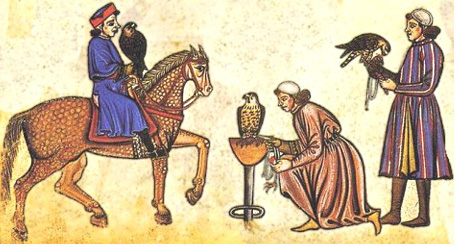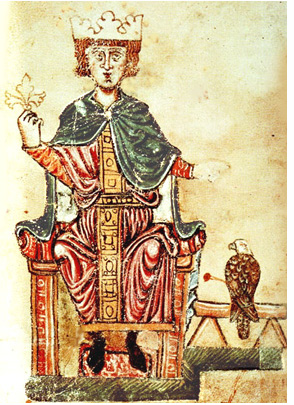...Best of Sicily presents... Best of Sicily Magazine. ... Dedicated to Sicilian art, culture, history, people, places and all things Sicilian. |
by Carlo Trabia | ||
Magazine Index Best of Sicily Arts & Culture Fashion Food & Wine History & Society About Us Travel Faqs Contact Map of Sicily |
Frederick dedicated the book (dictated to his scribes and clerks) to his out-of-wedlock son, Manfred , who later added notes to the work. Falconry was probably brought to Europe with the fall of the Roman Empire, when the Huns and Alans arrived from their eastern homelands. Though practiced in antiquity and favored in China and the Near East, falconry reached its zenith under the medieval Arabs, who probably introduced it in Sicily. Appropriately, the eagle was the heraldic symbol of Frederick's Hohenstaufen dynasty as emperors - an ancient Roman ensign inherited by the Germanic peoples. Two works are occasionally cited as influences. It was Frederick's court astrologer, Michael Scott, who translated (from the Arabic) into Latin Aristotle's treatise on animals. In fact, Frederick's treatise reflects a diversity of scholarly traditions from across the known world, representing one of the earliest and most significant challenges to Aristotle's explanations of nature. The guide authored by the Arab falconer Moamyn was translated at Frederick's court by Theodore of Antioch as De Scientia Venandi per Aves. A treatise attributed to the court of Henry II of England (whose daughter Joan wed William II of Sicily) may also have been an influence. However, the greater part of Frederick's treatise is based on his observation and experiments and that of the aristocrats of his realm. A testament to Frederick's intellectual curiosity, the book is rigorously scientific. The original manuscript was lost. The oldest existing copy (from which the illuminations shown here are reproduced) was commissioned by Manfred and is housed in the Vatican, and a French translation was completed around 1300. The first printed edition, a transcript of the original Latin, was published in Augsburg in 1596. The standard English translation is The Art of Falconry by Frederick II of Hohenstaufen by Wood and Fyfe.
In Frederick's day most hunting falcons were captives, and his book explains how to take young birds from their nests. An illustration even depicts this. We may presume, of course, that Frederick did not do so personally. Falconry was popular among the aristocracy, though when, in 1190, Richard Lionheart - en route to Messina - infamously tried to take a falcon from its nest in Calabria the regal bird was supposedly in the possession of a commoner. Later, when Charles V ceded Malta as a fief to the Knights of Saint John, the feudal rent was the annual payment of a Maltese falcon. Frederick's hunting was not confined to Sicily, which boasted far more more woods and bush land in the thirteenth century than it does today. He spent much time in Puglia and made forays into northern Italy and Germany as well as the eastern Mediterranean, and probably hunted wherever he went. Like many medieval monarchs who had to constantly defend their realms, Frederick travelled often. In the Palermo area he hunted in the preserve beyond the Genoard gardens, between Monreale and Altofonte. In medieval times falcons and the larger hawks usually attacked other birds, such as grouse, crows or magpies, but they could also hunt rabbit and various rodents. Typically, hunting with larger falcons is undertaken over large open tracts above which the falcon flies to strike or seize its prey before returning to cover. The ideal setting might be an area of low bush or fields bordering substantial woods. As depicted in Frederick's work, medieval falconers often hunted on horseback, a tradition preserved by today's Kazakhs and Mongolians. Falcon lovers will tell you that falcons, like dogs, are intelligent and loyal. At the very beginning of his treatise, Frederick tells us in no uncertain terms that falconry is the noblest form of hunting. Yet, another medieval sport that was the exclusive province of the aristocracy was jousting. It should be remembered that Frederick occupied his days with far more than falconry or fathering illegitimate children. Among the greatest of his efforts to survive him are the Constitutions of Melfi, a legal code centuries ahead of its time. About the Author: Carlo Trabia is an architect who lectures on architectural history. | |
Top of Page |
 If polo is the sport
of kings, falconry is the sport of emperors.
If polo is the sport
of kings, falconry is the sport of emperors.  The genus falco is thrives around the world. The falcon, of course,
is a noble bird of prey, and southern Italy is home to several varieties,
of which the peregrine falcon is perhaps the best known, and it is the falconer's
traditional choice of bird. The
The genus falco is thrives around the world. The falcon, of course,
is a noble bird of prey, and southern Italy is home to several varieties,
of which the peregrine falcon is perhaps the best known, and it is the falconer's
traditional choice of bird. The